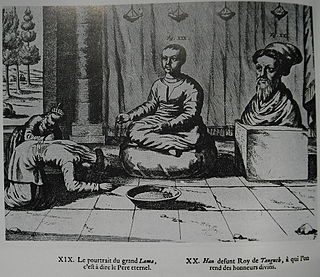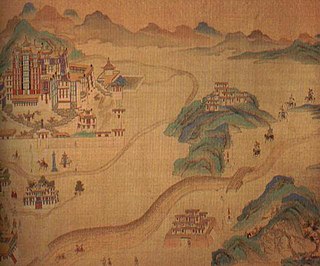
Tibet, or Greater Tibet, is a region in the central part of East Asia, covering much of the Tibetan Plateau and spanning about 2,500,000 km2 (970,000 sq mi). It is the homeland of the Tibetan people. Also resident on the plateau are some other ethnic groups such as the Monpa, Tamang, Qiang, Sherpa and Lhoba peoples and, since the 20th century, considerable numbers of Han Chinese and Hui settlers. Since the annexation of Tibet by the People's Republic of China in 1951, the entire plateau has been under the administration of the People's Republic of China. Tibet is divided administratively into the Tibet Autonomous Region, and parts of the Qinghai, Gansu, Yunnan and Sichuan provinces. Tibet is also constitutionally claimed by the Republic of China as the Tibet Area since 1912. Tibet is the highest region on Earth, with an average elevation of 4,380 m (14,000 ft). Located in the Himalayas, the highest elevation in Tibet is Mount Everest, Earth's highest mountain, rising 8,848.86 m (29,032 ft) above sea level.

While the Tibetan plateau has been inhabited since pre-historic times, most of Tibet's history went unrecorded until the introduction of Tibetan Buddhism around the 6th century. Tibetan texts refer to the kingdom of Zhangzhung as the precursor of later Tibetan kingdoms and the originators of the Bon religion. While mythical accounts of early rulers of the Yarlung Dynasty exist, historical accounts begin with the introduction of Buddhism from Nepal in the 6th century and the appearance of envoys from the unified Tibetan Empire in the 7th century. Following the dissolution of the empire and a period of fragmentation in the 9th-10th centuries, a Buddhist revival in the 10th–12th centuries saw the development of three of the four major schools of Tibetan Buddhism.

The Tibetan independence movement is the political movement advocating for the reversal of the 1950 annexation of Tibet by the People's Republic of China, and the separation and independence of Greater Tibet from China.
The foreign relations of Tibet are documented from the 7th century onward, when Buddhism was introduced by missionaries from India and Nepal. The Tibetan Empire fought with the Tang dynasty for control over territory dozens of times, despite peace marriage twice. Tibet was conquered by the Mongol Empire and that changed its internal system of government, introducing the Dalai Lamas, as well as subjecting Tibet to political rule under the Yuan dynasty. Tibetan foreign relations during the Ming dynasty are opaque, with Tibet being either a tributary state or under full Chinese sovereignty. But by the 18th century, the Qing dynasty indisputably made Tibet a subject. In the early 20th century, after a successful invasion, Britain established a trading relationship with Tibet and was permitted limited diplomatic access to "Outer Tibet", basically Shigatse and Lhasa. Britain supported Tibetan autonomy under the 13th Dalai Lama but did not contest Chinese suzerainty; while "Inner Tibet", areas such as Amdo and Kham with mixed Chinese and Tibetan populations to the east and north, remained nominally under the control of the Republic of China although that control was seldom effective. Although the sovereignty of Tibet was unrecognized, Tibet was courted in unofficial visits from Nazi Germany, Imperial Japan, and the United States during and after World War II. The foreign relations of Tibet ended with the Seventeen Point Agreement that formalized Chinese sovereignty over most all of political Tibet in 1951.

Ngawang Lobsang Thupten Gyatso Jigdral Chokley Namgyal, abbreviated to Thubten Gyatso was the 13th Dalai Lama of Tibet, enthroned during a turbulent era and the collapse of the Qing Dynasty. Referred to as "the Great Thirteenth", he is also known for redeclaring Tibet's national independence, and for his reform and modernization initiatives.

Kelzang Gyatso, also spelled Kalzang Gyatso, Kelsang Gyatso and Kezang Gyatso, was the 7th Dalai Lama of Tibet, recognized as the true incarnation of the 6th Dalai Lama, and enthroned after a pretender was deposed.

Amban is a Manchu language term meaning "high official", corresponding to a number of different official titles in the imperial government of Qing China. For instance, members of the Grand Council were called Coohai nashūn-i amban in the Manchu language and Qing governor-generals were called Uheri kadalara amban.
The Tibetan sovereignty debate refers to two political debates. The first political debate is about whether or not the various territories which are within the People's Republic of China (PRC) that are claimed as political Tibet should separate themselves from China and become a new sovereign state. Many of the points in this political debate rest on the points which are within the second historical debate, about whether Tibet was independent or subordinate to China during certain periods of its recent history.

The Xinhai Lhasa turmoil was an ethnic clash in Lhasa, Tibet, as well as a series of mutinies following the Wuchang Uprising. It effectively resulted in the end of Qing rule in Tibet.

Tibet came under the control of People's Republic of China (PRC) after the Government of Tibet signed the Seventeen Point Agreement which the 14th Dalai Lama ratified on 24 October 1951, but later repudiated on the grounds that he had rendered his approval for the agreement under duress. This occurred after attempts by the Tibetan Government to gain international recognition, efforts to modernize its military, negotiations between the Government of Tibet and the PRC, and a military conflict in the Chamdo area of western Kham in October 1950. The series of events came to be called the "Peaceful Liberation of Tibet" by the Chinese government, and the "Chinese invasion of Tibet" by the Central Tibetan Administration and the Tibetan diaspora.

The Ming dynasty considered Tibet to be part of the Western Regions. While the Ming dynasty at its height had some degree of influence in Tibet, the exact nature of their relations is under dispute by modern scholars. Analysis of the relationship is further complicated by modern political conflicts and the application of Westphalian sovereignty to a time when the concept did not exist. The Historical Status of China's Tibet, a book published by the People's Republic of China, asserts that the Ming dynasty had unquestioned sovereignty over Tibet by pointing to the Ming court's issuing of various titles to Tibetan leaders, Tibetans' full acceptance of the titles, and a renewal process for successors of these titles that involved traveling to the Ming capital. Scholars in China also argue that Tibet has been an integral part of China since the 13th century and so it was a part of the Ming Empire. However, most scholars outside China, such as Turrell V. Wylie, Melvyn C. Goldstein, and Helmut Hoffman, say that the relationship was one of suzerainty, Ming titles were only nominal, Tibet remained an independent region outside Ming control, and it simply paid tribute until the Jiajing Emperor, who ceased relations with Tibet.

Tibet was a de facto independent state in East Asia that lasted from the collapse of the Manchu-led Qing dynasty in 1912 until its annexation by the People's Republic of China in 1951.

The Battle of Chamdo occurred from 6 to 24 October 1950. It was a military campaign by the People's Republic of China (PRC) to take the Chamdo Region from a de facto independent Tibetan state. The campaign resulted in the capture of Chamdo and the annexation of Tibet by the People's Republic of China.
The Batang uprising was an uprising by the Khampas of Kham against the assertion of authority by Qing China.
The Lhasa riot of 1750 or Lhasa uprising of 1750 took place in the Tibetan capital Lhasa, and lasted several days during the period of the Qing dynasty's patronage in Tibet. The uprising began on 11 November 1750 after the expected new regent of Tibet, Gyurme Namgyal, was assassinated by two Qing Manchu diplomats, or ambans. As a result, both ambans were murdered, and 51 Qing soldiers and 77 Chinese citizens were killed in the uprising. A year later the leader of the rebellion, Lobsang Trashi, and fourteen other rebels were executed by Qing officials.

The Ganden Phodrang or Ganden Podrang was the Tibetan system of government established by the 5th Dalai Lama in 1642, after the Oirat lord Güshi Khan who founded the Khoshut Khanate conferred all temporal power on the 5th Dalai Lama in a ceremony in Shigatse in the same year. Lhasa again became the capital of Tibet, and the Ganden Phodrang operated until the 1950s. The Ganden Phodrang accepted China's Qing emperors as overlords after the 1720 expedition, and the Qing became increasingly active in governing Tibet starting in the early 18th century. After the fall of the Qing empire in 1912, the Ganden Phodrang government lasted until the 1950s, when Tibet was annexed by the People's Republic of China. During most of the time from the early Qing period until the end of Ganden Phodrang rule, a governing council known as the Kashag operated as the highest authority in the Ganden Phodrang administration.

Tibet under Qing rule refers to the Qing dynasty's rule over Tibet from 1720 to 1912. The Qing rulers incorporated Tibet into the empire along with other Inner Asia territories, although the actual extent of the Qing dynasty's control over Tibet during this period has been the subject of political debate. The Qing called Tibet a fanbu, fanbang or fanshu, which has usually been translated as "vassal", "vassal state", or "borderlands", along with areas like Xinjiang and Mongolia. Like the preceding Yuan dynasty, the Manchus of the Qing dynasty exerted military and administrative control over Tibet, while granting it a degree of political autonomy.

The Convention of Lhasa, officially the Convention Between Great Britain and Thibet, was a treaty signed in 1904 between Tibet and Great Britain, in Lhasa, the capital of Tibet, then a protectorate of the Qing dynasty. It was signed following the British expedition to Tibet of 1903–1904, a military expedition led by Colonel Francis Younghusband, and was followed by the Anglo-Chinese Convention of 1906.

The priest and patron relationship, also written as priest-patron or cho-yon, is the Tibetan political theory that the relationship between Tibet and China referred to a symbiotic link between a spiritual leader and a lay patron, such as the historic relationship between the Dalai Lama and the Qing emperor. They were respectively spiritual teacher and lay patron rather than subject and lord. Chöyön is an abbreviation of two Tibetan words: chöney, "that which is worthy of being given gifts and alms", and yöndag, "he who gives gifts to that which is worthy".

The 1720 Chinese expedition to Tibet or the Chinese conquest of Tibet in 1720 was a military expedition sent by the Qing dynasty to expel the invading forces of the Dzungar Khanate from Tibet and establish Qing rule over the region, which lasted until the empire's fall in 1912.













